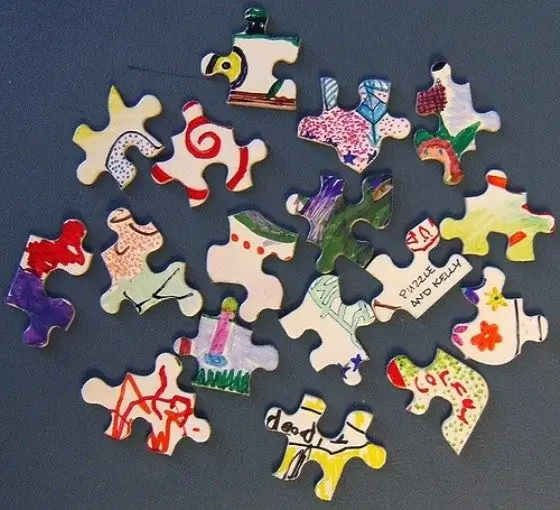Jigsaw is a puzzle game in which you have to make a mosaic from a large number of pieces of a drawing of different shapes. Making such a puzzle is a very exciting activity, which you can devote to family leisure. You can draw or choose a picture, as well as the size of the puzzle pieces themselves: large ones are better for a small child, and smaller ones for older children or even adults.

How to make a puzzle based on a picture
To make a puzzle based on a drawn picture, you will need:
- scissors;
- paper;
- glue;
- ruler;
- the pencils;
- thick cardboard.
Draw any picture on a piece of paper. Also, do not forget to make a photocopy - you can use it as a guide when making the mosaic.
Stick the picture onto thick cardboard, then leave it to dry completely. Then flip the image right-side down.
Using a ruler, sketch out a grid, which should be made up of shapes of various sizes. Use a stationery knife or scissors to cut the puzzle along the lines.
Your puzzle game is ready. Mix the pieces together and enjoy assembling them.
How to make a jigsaw puzzle based on a photo
There are more complex ways to make a homemade puzzle, which can serve, for example, as an original birthday present for a friend. To do this, you will need:
- color printer on which you can print a high-quality A4 photo;
- thick cardboard that will fit your printed photo;
- PVA glue;
- scissors;
- pencil.
If you want to make a fairly large jigsaw puzzle, it is worth contacting special studios that print large-format photos for printing photos.
So, stick the printed photo to the cardboard and wait for your product to dry completely. Then cut off the excess cardboard so that the edges of the photo are exactly aligned with the edges of the cardboard and have the same shape.
After that, on the back of the cardboard, using a regular pencil, draw the markings along which you will need to cut out the pieces of the puzzle. If you are making a puzzle for adults, try to make the puzzle pieces more complex than simple geometric shapes. Use not only straight lines, but also semicircles and geometric shapes at various angles. Thus, you will make the process of assembling a homemade puzzle as difficult as possible.
In printing houses, there are special machines that will allow you to cut your photo in different ways. This option may come in handy in case you are in a hurry with a gift or you are too lazy to wield scissors, but you still want to give an original gift. When the pieces of the puzzle are cut, try to assemble them yourself into the original picture. When doing this, make sure they fit well enough together.
How to make a jigsaw puzzle for a kid
To make a soft puzzle with your own hands for a small child, you will need:
- several sheets of multi-colored porous rubber;
- scissors;
- household cellulose napkins.
Cut out any figurines that are familiar to your child from rubber sheets and stick them onto a cellulose napkin. After that, using scissors, cut the resulting figures into 2-3 pieces.
For kids who have not yet fully acquired the skills of folding puzzles, it is best to cut the picture into 2 equal parts. After a while, when the baby can easily put the picture together, you can cut each piece of the puzzle game into 2 more parts.
Alternatively, you can use a bright page from an old illustrated magazine to make a jigsaw puzzle, glue it onto cardboard, and cut it into squares, triangles, or other geometric shapes. Even if there is no cardboard at hand - it doesn't matter! Use the easiest way to make a jigsaw puzzle for a child - take an old and resilient postcard with color illustrations and cut it into pieces.
Parents are advised to put homemade puzzles in a bag or envelope so that they do not look for them all over the room later. In this way, you can create a variety of puzzles for your child, allowing him to develop fine motor skills and thinking.






